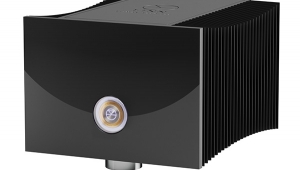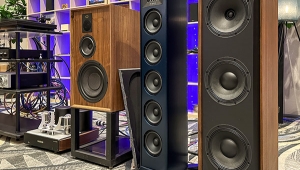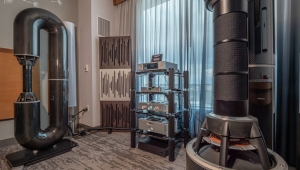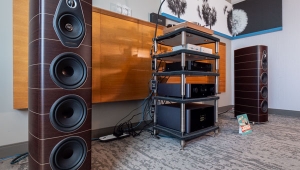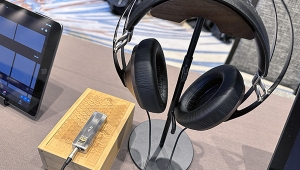| Columns Retired Columns & Blogs |
Digital Recordings Audio-CD
I had been with Stereophile only six months and feared my tenure was over—I thought I was losing my hearing. There was pain, ringing, and stuffiness. I couldn't listen to anything.
With great fear, I submitted to a full ear/nose/throat workup, part of which was a test of my hearing by an audiologist. I sat in a soundproof booth wearing a pair of ancient Koss Stereophones, indicating with a wave of my hand when I heard a sound. With an inferred pat on the back, the audiologist told me that my hearing was normal and advised that I take sinus meds as needed.
But a glance at the audiogram was not reassuring: Tested frequencies ranged from 50Hz to 8kHz, with wide intervals between them, and the intensity scale had 3dB intervals—a much less stringent regimen than we audiophiles demand.
But did I really want to know more? How embarrassing it would be to find out that my hearing was severely limited in bandwidth, and/or highly nonlinear! Moreover, at the advanced age of 57, a significant degree of age-related HF rolloff (presbycusis) should be expected, especially since I've spent most of my life in New York's cacophony. (The Digital Recordings website has some useful information and links about hearing loss.) The upside of a better test might be an insight into why I preferred certain components. The downside was that, if it turned out that my hearing was really poor, I (and others) might discount my subjective evaluations. But, since knowing is usually better than wondering, I obtained a copy of Digital Recordings' Audio-CD, a DIY audiology test tool, and subjected myself and friends to it.
How it works
Developed by Dr. Marek Roland-Mieszkowski, the Audio-CD permits useful evaluation of hearing thresholds with only a CD player and a pair of headphones. It presents calibrated bandwidth-specific chirps of increasing amplitude at each of 24 frequencies, from 20Hz to 20kHz. A separate track is provided for each frequency, and the chirps are presented only in the left channel. A neat feature of this CD is that each succeeding group of chirps is 1dB louder than the preceding group and played 1 second later. If you look at the track/time counter on your CD player just as soon as you hear something, the time counter (0 to 1:20) will indicate the intensity threshold (0 to 80dB) for the frequency on that track. Write down the track number and time indication and jump to the next track. When you've tested the left ear, reverse the headphones to test the right.
You are instructed to have a young subject—with, presumably, good hearing—listen to track 2 and adjust the volume until the tones are just barely audible. In this age of overdriven portable CD players, finding such a youngster may not be easy. On the other hand, the Audio-CD tests relative, not absolute, thresholds, so the initial setting is not very critical. (It can also be used to test absolute values, though that requires additional calibration equipment.)
Certain other conditions must be observed. First, your CD player and headphones must play the low-frequency tones on the test tracks with no additional clicks or noises, which could indicate aliasing or excessive harmonic distortion. None of the players I tried, from an ancient Magnavox CD473 to a new Meridian 800, had any problems with the test. Second, avoid anticipating the tones—don't stare at the timer display. My most consistent results were obtained when the subject couldn't see the display at all and another person recorded the results. Finally, and most critically, you need extreme quiet so that any background noise will not mask the lowest intensities.
It was impossible to find a completely quiet place in New York City. For the initial tests, I used the trusty Sennheiser HD600 headphones. However, from about 100Hz to about 1000Hz, the NYC audiograms (fig.1, Subject 1, blue trace) had 10dB+ higher thresholds than those made in quiet, rural Connecticut. After consultation, Sennheiser provided a set of calibrated, closed-back headphones, the HDA200s, which I used for the balance of the tests. With the HDA200s I observed consistently lower thresholds across the 100–1000Hz band, which I attribute to the masking effects of low-level ambient noises. The slightly elevated HF thresholds with the HDA200s (compare the green Subject 1 trace with the blue Sennheiser trace) are probably due to the slight HF rolloff seen in the HDA200's calibration curves on the Sennheiser website. There were, fortunately, no significant left/right sensitivity differences in the subjects tested.

Fig.1 Measured hearing thresholds: Reference (black); Subject 1 with Sennheiser HD600 headphones (blue); Subject 1 with Sennheiser HDA200 headphones (green); Subject 2 (red). In both graphs, scores above 80 indicate that the subject made no response.
The envelope, please
The results in figs.1 and 2 are presented as curves of threshold intensity with the vertical axis inverted. Thus, the lower the data point, the lower the spl threshold at that particular frequency and, conversely, the higher the absolute sensitivity. Note that this is not a graph of frequency response. The Audio-CD gives only a measurement of one's thresholds of signal detection, not of signal sensitivity. It is not intended to test whether one's hearing has a linear dynamic response above the hearing threshold. (I didn't try it, but I imagine that, with an accurately calibrated gain control, one could use the Audio-CD for assessing sensitivity.)

Fig.2 Difference between measured hearing thresholds and reference threshold: Subject 1 with Sennheiser HD600 headphones (blue); Subject 1 with Sennheiser HDA200 headphones (green); Subject 2 (red).
The red traces in figs.1 & 2 show that from 20Hz up to about 2kHz, my hearing proved similar to that of the "ideal" threshold curve provided with the Audio-CD. Above that, my thresholds are elevated a few dB (fig.2, red trace), but with sensitivity maintained out to about 18kHz. The Digital Recordings website says that "an upward deviation of more than 10dB from an 'ideal' threshold indicates a hearing loss," and characterizes losses in the 10–24dB range as "slight." So, except for the range above 12kHz, my hearing (Subject 2 in these graphs) is close to ideal, especially considering my age and usual haunts. Above that, the loss is "slight." In fact, some of this apparent loss is probably due to the HDA200's rolloff.
Most satisfying was that my curve is relatively smooth, without troughs or peaks. In other words, my hearing loss is a minor one that could be easily compensated for with a first-order shelf boost from about 1kHz up, something that's child's play with the Z-Systems RDP-1 digital equalizer that I reviewed in July 1998.
Accurate compensation for my threshold curve with the RDP-1, using low-noise components and sources, made everything sound as forward and intense to me as it did to others in the room. Perhaps, over time, I might adapt to such a correction and find greater listening pleasure, but the probable concomitant would be that live music would then sound muffled.
Considering the slightness of my hearing loss, that's too high a price. Even without compensation, I'm quite conscious of subtle background noise levels; now I can attribute this to the effect of in-band and out-of-band frequencies, and their ability to mask low-level HF information with my reduced thresholds.
On the other hand, had my test results indicated a greatly raised threshold in a moderately narrow band of frequencies, compensation might have been more useful. For example, I tested a friend (Subject 1, blue and green traces in figs.1 & 2) who is an avid music lover but who has suffered from considerable high-frequency loss over the years. In his case, the loss is so substantial that he is nearly always aware of it and cannot make an adequate psychophysical compensation. His clinical audiology results were as sketchy as mine (same lab), but, using the Audio-CD, we were able to get results that we could transfer to a custom fixed equalizer with a boost of about 48dB(!) centered at 8kHz with 24dB/octave slopes. With this filter, music began to sound a bit more as he remembered it. With this filter, the sound was unlistenable for others and dangerous even for the subject. Peak limits were required to prevent further hearing damage.
Why do you want to know?
Within our little world of audiophilia, it is important for each of us to have some idea what our ear-brain mechanism is doing. Only then can one have any idea of how capable one is of assessing, to say nothing of offering opinions about, sound quality. In our noisy world, it is all too common that a brief exposure to very high signal levels results in temporary or permanent hearing loss due to the destruction of the irreplaceable hearing transducers—the hair cells of the inner ear.
Digital Recordings' Audio-CD can tell you whether there are significant gaps in your hearing. Narrow-bandwidth gaps disturb the natural balance of musical voices; you might search forever for a satisfying system or, indeed, a satisfying concert experience. Don't you know someone who just keeps turning it up, louder and louder, to no avail? Do you really want to know why?
- Log in or register to post comments

















